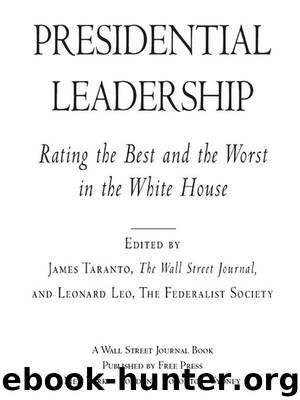Presidential Leadership by James Taranto & Leonard Leo

Author:James Taranto & Leonard Leo
Language: eng
Format: epub
Publisher: Free Press
Published: 2004-07-15T00:00:00+00:00
29.
Warren
Gamaliel
Harding
SURVEY RANKING : 37 (tie with Franklin Pierce)
BORN : November 2, 1865, Blooming Grove, Ohio
WIFE : Florence Mabel Kling
RELIGION : Baptist
PARTY : Republican
MILITARY EXPERIENCE : None
OTHER OFFICES HELD : Ohio state senator (1899–1903), lieutenant governor (1904–05), U.S. senator (1915–21)
TOOK OFFICE : March 4, 1921
VICE PRESIDENT : Calvin Coolidge
DIED IN OFFICE : August 2, 1923
BURIED : Marion, Ohio
By Jeremy Rabkin
No one ranks Warren G. Harding among our greatest presidents. His administration did not face the sorts of challenges that call for heroic leadership. Harding came to office when the Great War had already been won—and President Wilson’s peace treaty had already been rejected by the Senate.
Still, Harding must be considered the most successful postwar president in American history. Andrew Johnson faced impeachment after the Civil War. Harry Truman left office with less support, in the opinion polls, than Richard Nixon retained on the day he resigned. Bill Clinton, coming to office after decades of Cold War, also squandered the public’s trust and ended up facing impeachment.
Harding remained quite popular when he died in 1923. Unlike other postwar presidents, Harding’s policies received the endorsement of the electorate. In two successive presidential elections after his death, voters returned close political associates of Harding to the White House and confirmed large majorities in both houses of Congress for his party.
Harding recruited men of distinction to his administration. His cabinet included a future chief justice (Secretary of State Charles Evans Hughes), a future president (Commerce Secretary Herbert Hoover), and the only treasury secretary in American history to win the confidence of three successive presidents (Andrew Mellon, who served continuously from 1921 to 1932). Harding was not afraid to give prominent positions to men who might outshine him. He appointed a former president, William Howard Taft, as chief justice.
The Harding administration launched the economic boom that continued through the 1920s. A continued series of tax cuts revived investment. The tax cuts were accompanied by disciplined reductions in spending. Harding was the only postwar president to reduce federal expenditures below their prewar levels.
At least some of the administration’s success in reducing federal spending should be credited to the efforts of the Bureau of the Budget. This office provided systematic executive oversight of federal spending patterns for the first time. In the previous administration, proposals to establish such an agency had foundered on conflicting claims for control between Congress and the president. The Harding administration fostered the compromise, embodied in legislation of 1921, that remains to this day: a separate General Accounting Office for Congress and a budget bureau (now called the Office of Management and Budget) that answers exclusively to the president.
Tax cuts were offset by an increase in the tariff. But here too the Harding administration laid a foundation for future reform by persuading Congress to establish an independent tariff commission (whose functions have devolved to today’s International Trade Commission and U.S. trade representative). The Tariff Commission provided, for the first time, some specialized administrative guidance to congressional tariff setting, historically characterized by open-ended logrolling.
In foreign
Download
This site does not store any files on its server. We only index and link to content provided by other sites. Please contact the content providers to delete copyright contents if any and email us, we'll remove relevant links or contents immediately.
| Anarchism | Communism & Socialism |
| Conservatism & Liberalism | Democracy |
| Fascism | Libertarianism |
| Nationalism | Radicalism |
| Utopian |
The Secret History by Donna Tartt(18152)
The Social Justice Warrior Handbook by Lisa De Pasquale(11950)
Thirteen Reasons Why by Jay Asher(8450)
This Is How You Lose Her by Junot Diaz(6431)
Weapons of Math Destruction by Cathy O'Neil(5825)
Zero to One by Peter Thiel(5487)
Beartown by Fredrik Backman(5349)
The Myth of the Strong Leader by Archie Brown(5236)
The Fire Next Time by James Baldwin(5015)
How Democracies Die by Steven Levitsky & Daniel Ziblatt(4950)
Promise Me, Dad by Joe Biden(4907)
Stone's Rules by Roger Stone(4852)
100 Deadly Skills by Clint Emerson(4686)
A Higher Loyalty: Truth, Lies, and Leadership by James Comey(4546)
Rise and Kill First by Ronen Bergman(4542)
Secrecy World by Jake Bernstein(4387)
The David Icke Guide to the Global Conspiracy (and how to end it) by David Icke(4376)
The Farm by Tom Rob Smith(4320)
The Doomsday Machine by Daniel Ellsberg(4242)
